●Dates:
●Venue:
●Number of Visitors:
●Organizer:
●Special
Sponsor:
|
Saturday 9th September 2006, 13:00-16:00
Hyogo Animal well-being center
50
Hyogo Animal well-being center /
NPO Knots
Nestle
Purina PetCare
|
|
|
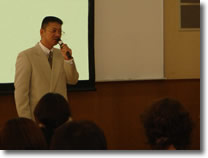 Rebecca Rhoades D.V.M. (Dr. Becky) was invited to the Hyogo Prefecture Animal Well-being
Center as a special guest lecturer. Dr. Becky is the Executive Director of the Kauai Humane
Society in Hawaii. She was on a visit to Japan to speak at the 6th Live Love Animals
International Symposium 2006 (organized by the NPO Knots and held on 10th September under
the theme 'The Future of Shelter Management in Japan - Working in Cooperation with Public Rebecca Rhoades D.V.M. (Dr. Becky) was invited to the Hyogo Prefecture Animal Well-being
Center as a special guest lecturer. Dr. Becky is the Executive Director of the Kauai Humane
Society in Hawaii. She was on a visit to Japan to speak at the 6th Live Love Animals
International Symposium 2006 (organized by the NPO Knots and held on 10th September under
the theme 'The Future of Shelter Management in Japan - Working in Cooperation with Public
Organizations'.)
First, Dr. Kono, a manager at Hyogo Prefecture Animal Well-being Center introduced Dr.
Becky to everyone. |
|
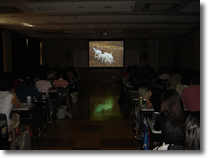 Following that, a video was shown entitled 'Power of Compassion'. This video is used by Dr.
Becky for training potential volunteers at the Kauai Humane Center. At their orientation,
these volunteers also learn how to handle animals, look around the facility, find out where
caution is needed, and receive instruction. Following that, a video was shown entitled 'Power of Compassion'. This video is used by Dr.
Becky for training potential volunteers at the Kauai Humane Center. At their orientation,
these volunteers also learn how to handle animals, look around the facility, find out where
caution is needed, and receive instruction.
The video explains the following.
First, the history of companion animals is introduced - how humans bred dogs for specific
traits and purposes and, in so doing, created a variety of breeds. The video points out how
dogs, as companion animals, rely for much of their existence on humans (in terms of food,
daily care and operations). However, many so-called dog owners, people who are supposed to
be responsible and to give their animal a lifetime of love and care, end up bringing their
pet to a shelter. Their reasons are varied. They say things such as; 'the animal cannot be
disciplined', or 'he bites', 'we did not realize they grew so big', or 'we're moving and
can't take a pet' etc. The shelters are also home to many animals that have been abused,
neglected or have an incurable disease, etc.
The video continues by showing that shelters do their best to try and find new owners, but if an animal has an incurable disease, serious injury, or is too old and suffering, then euthanasia is the only alternative. Only well-trained, skillful professionals perform these procedures, and in the most humane way possible. Unfortunately, if after a few months of trying to locate original owners, or new owners, there is no success then healthy animals also have to be put down. The reason is simple - the shelters will become over-crowded. Of course, this sad option is not a solution to over-opulation.
The video asks: Do the public know that these professionals have to make these tough and
miserable decisions? How can we possibly feel anger towards people who have such a difficult role?
The video once more strongly emphasizes that we humans have the responsibility for looking
after companion animals until their last day. It also suggests that, in order to reduce animal suffering, and reduce the numbers brought to shelters, we must all think of ways to solve the problems and how we can help. The video asks us to choose to give our power to make society better for both humans and animals. The video title is 'Power of Compassion', meaning that we need to combine our passions to create a better world.
The video was about 20 minutes long and contained imagery of euthanasia and neglected animals. Every member of the audience will have been deeply moved without a doubt.
At Kauai Humane Society, people sign up to be registered volunteers only after they have received this orientation. It is clearly a good idea that volunteers only start working based on a solid understanding of the purpose and the content of the work. |
| |
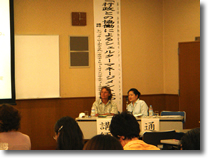 After screening the video, Dr. Becky talked about 'Community Animal Management' at Kauai
Humane Society. Kauai Humane Society is a private non-profit organization performing
service work entrusted by the local government for animal control and management. It has a
long history and was established in 1952. The Society protects and organizes adoptions for
stray and lost animals, provides discount coupons for low-income owners to have their
animals spayed or neutered, teaches humane issues to young people, performs field work, and
promotes itself to the community as a facility for society's betterment. The Society runs
some shelters, and these serve not only lost and abandoned animals but also animals
requiring temporary care (similar to the role of a pet hotel). This indicates the high
level of trust the shelters enjoy with the public.The society provides the best possible care in terms of cleanliness and services, etc.) Dr.
Becky explained that, no matter how good the facility building is, it is meaningless if the
content is poor. More than anything else, she stressed the importance of winning trust from
the local community and giving them a sense of security about the facility. She also said
that, regardless of the underlying causes, it is important to have a place to keep animals.
Currently, she has 12 staff and many volunteers looking after approximately 150 dogs and
200 cats. After screening the video, Dr. Becky talked about 'Community Animal Management' at Kauai
Humane Society. Kauai Humane Society is a private non-profit organization performing
service work entrusted by the local government for animal control and management. It has a
long history and was established in 1952. The Society protects and organizes adoptions for
stray and lost animals, provides discount coupons for low-income owners to have their
animals spayed or neutered, teaches humane issues to young people, performs field work, and
promotes itself to the community as a facility for society's betterment. The Society runs
some shelters, and these serve not only lost and abandoned animals but also animals
requiring temporary care (similar to the role of a pet hotel). This indicates the high
level of trust the shelters enjoy with the public.The society provides the best possible care in terms of cleanliness and services, etc.) Dr.
Becky explained that, no matter how good the facility building is, it is meaningless if the
content is poor. More than anything else, she stressed the importance of winning trust from
the local community and giving them a sense of security about the facility. She also said
that, regardless of the underlying causes, it is important to have a place to keep animals.
Currently, she has 12 staff and many volunteers looking after approximately 150 dogs and
200 cats.
|
| |
In her lecture, she had two more pieces of advice that are particularly noteworthy. One was
that, in shelter management, there are several important points for success.
| 1. |
Be transparent: This means 'not hiding', 'being open' and 'letting people know what
the shelter is doing'. |
| 2. |
Have faith in everyone: do not distinguish between staff and volunteers. |
| 3. |
Provide the best quality and most considerate community services. |
4. |
Create goals and aims. Then put every effort into achieving them. |
| 5. |
Work hard and be resourceful in raising funds, (not for profit-making but for
helping reach goals). |
She said that these five points may seem easy to achieve but are not so simple in practice.
But if they can be achieved then people working in shelters can feel a new pride in their
work and provide high quality care and programs such as discipline classes and volunteer
training, etc.
|
| |
 Dr. Becky's second thought-provoking point was that her current shelter building was built after a strong hurricane (Hurricane Iniki) hit Kauai Island. Therefore the new shelter was designed with a basement and built strongly to withstand big disasters. People, as well as the animals, can escape to this shelter. Dr. Becky's second thought-provoking point was that her current shelter building was built after a strong hurricane (Hurricane Iniki) hit Kauai Island. Therefore the new shelter was designed with a basement and built strongly to withstand big disasters. People, as well as the animals, can escape to this shelter. |
| |
People (and animals) in and around Kobe also experienced such a disaster when struck by the
Great Hanshin-Awaji Earthquake. When that earthquake hit, many people could not take their
pets to a shelter. Some people escaped, but left their pets behind, while others refused to
leave and stayed put within their damaged homes together with their pets. But at Dr.
Becky's shelter, pets and owners do not have to be separated. As pet owners we were very
impressed by such an excellent system.
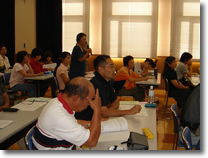 About 50 participants came from all over Japan to join this lecture. There were civil
servants, shelter managers and other individuals supporting, or wanting to help with, About 50 participants came from all over Japan to join this lecture. There were civil
servants, shelter managers and other individuals supporting, or wanting to help with,
animal rescue activities.
During the question and answers time, there were several good questions and we are
confident that people went away with some very useful tips from Dr. Becky. The time was
limited but very fruitful.We are hopeful that this talk has provided a good source of reference for future shelter
management in Japan.
|
| |
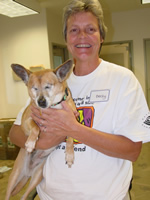 |
| Dr.Becky Mahalo & Aloha !! |
|
| |
|